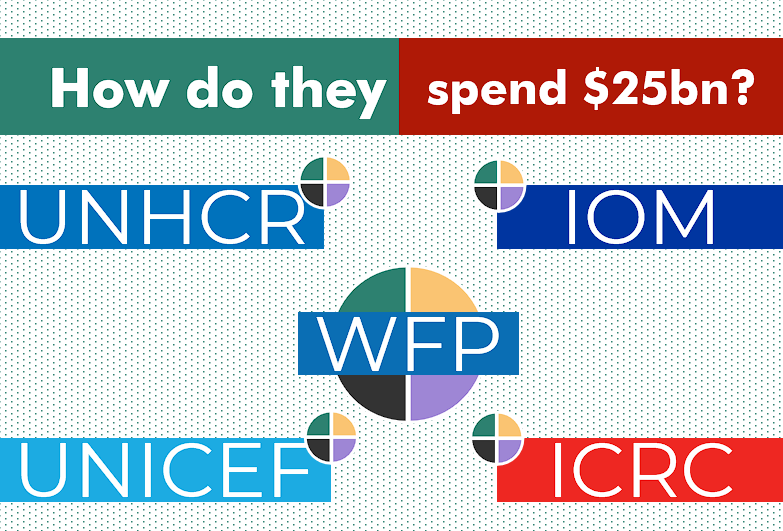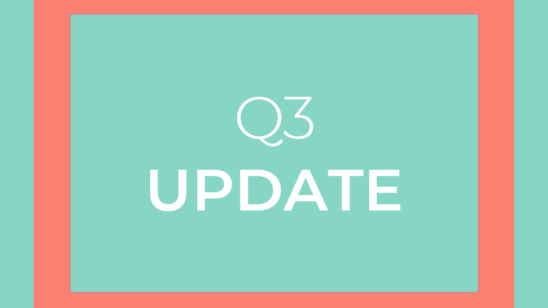
How do the big agencies spend their money?8 min read
In the past decade, the expenditure of five of the largest humanitarian agencies has ballooned. In 2012, the combined expenditure of WFP, UNICEF, UNHCR, IOM, and ICRC was $12.7bn – a huge amount. Nine years later and the combined expenditure of these agencies was over $25bn.
These are vast amounts of money. In the 2012-2021 period, these agencies alone spent $187bn.
But how do they actually spend their money? And how has it changed over time? When we’re dealing with such a huge amount of money every year as a sector, these questions matter. These are the questions we’ll explore in this story by looking at each of these agencies in turn. We’ve scoured 53 annual reports and have picked out some highlights that we think you’ll find interesting.
Cash, precarious working, and staff costs
One of the difficult things to do is to make cross-agency comparisons. In many cases these organisations use different cost categories in their accounts so that makes things tricky. But we can still pick out a few things.
Firstly, the trend towards cash as an operating modality is apparent. We can see this in nearly all agencies to varying degrees, and particularly at WFP. This also raises questions regarding a possible tension between cash and localisation – is more money going to cash, rather than local NGOs? More on this below.
Secondly, precarious working seems to be on the up. WFP and UNHCR, in particular, are spending more on more temporary forms of working. What does this mean for the people that make the sector work?
Thirdly, staff costs account for different amounts across agencies. This reflects differing operating models: low overheads due to food and cash (WFP), outsourcing staff costs to partners (UNICEF and UNHCR), or internalising the costs (ICRC).
World Food Programme, or the World Cash Programme?
WFP’s turn to cash as a response modality is not a surprise to anyone. What is interesting, however, is the speed at which the shift to cash has happened. Back in 2011, WFP spent only 3% of their expenditure on cash and voucher assistance – that equals $121m. A decade later and cash represented 26% ($2.3bn) of total expenditure, not far off the 32% that WFP spends on food.
The shift towards cash is stark and represents a broader trend in the sector.
WFP isn’t just changing how it spends money on food or cash. They’re also changing how they spend money on human resources.
WFP now spends 31% of their staff costs on the precarious work contracts of temporary staff and consultants, up from only 13% a decade ago. Spend on consultants increased from $39m to $207m across the period, as did spend on temporary staff from $46m to $180m.
This shift away to less secure forms of employment is also apparent in other agencies. For example, UNHCR appears to have increased spend on consultants across the same period.
UNICEF have changed slightly, but not by much
Whilst WFP has seen a big transition over the past decade, the same cannot be said for UNICEF. UNICEF have experienced subtle shifts in their expenditure over the past decade.
Between 2015 and 2021, UNICEF’s transfer of money to implementing partners reduced from 35% of all expenditure to 29%. Yet between 2016 and 2021, UNICEF’s cash directly to beneficiaries increased from 0% to 4%.
Could there be a substitution effect between funding implementing partners, and direct cash assistance?
However, the overall cost base has remained relatively stable. Transfer of programme supplies increased slightly since 2012 (up 0.8% points), whilst employee benefits decreased 4.2% points.
Cash assistance (to partners and beneficiaries) accounted for 35% of their expenditure in 2021, followed by 24% on employees, 18% on programme supplies, and 16% on ‘other expenses’.
UNHCR have shifted slightly away from implementing partners
The slight movements in the UNICEF cost base are also reflected in the UNHCR accounts – except just a bit more exaggerated.
UNHCR used to spend 38% on implementing partners in 2012, and now spends 29%. Staff costs are only down by a couple of percentage points. And there has been a similar growth in cash to beneficiaries.
Cash used to represent only 4% of their expenditure ($103m), but this has since grown to 12% ($573m). This again poses the question of a potential substitution effect between direct cash assistance and money to implementing partners.
Could the growth in cash assistance put more money into the coffers of international actors who now spend less on implementing partners, and could there be a tension between cash and localisation? (We’ll explore this in a future story).
Another interesting trend is that of ‘contractual services’. UNHCR now spends 11% on contractual services (up from 7% a decade ago). This bucket includes: individual contractors, construction contracts, advertising, transport, professional services etc.
The biggest driver of this is the increase of “affiliated workforce and individual contractors” which now accounts for 3.5%. At the same time, salaries and employee benefits accounts for 2.7% less. This reflects a similar trend in the WFP accounts towards precarious working, although to a lesser extent.
IOM now spending more on staff and implementing partners
A decade ago there were two big cost drivers at IOM: staff costs and ‘contractual services’. This still remains the case, but staff costs have expanded. Staff salaries and benefits now account for 32% of expenditure, up from 23% in 2011. This change is particularly evident since 2017 – prior to this salaries accounted for $300-$400m roughly, but this has since expanded to $812m in 2021.
Unlike other agencies, where money to partners is now less of the overall pie, IOM has expanded the amount going to implementing partners slightly. Money to implementing partners is up from 6.5% a decade ago, to 10.5% in 2021.
And the good news is that this is fairly evenly split. National civil society organisations (52%) and national governments (2%) account for over half of these implementing partner transfers of money, compared to 48% for UN/international organisations.
ICRC’s huge staff cost base
ICRC is different than the other organisations we’ve looked at. On the surface, it is a bit smaller (only $2.1bn in 2021), and not a UN agency. But the differences are more substantial than this, particularly in terms of its cost base.
ICRC spends nearly half of all expenditure on staff costs. This is greater as a proportion of overall expenditure than any of the other organisations we’ve examined. Indeed, in 2020, ICRC spent over half of its expenditure on staff.
This reflects the different operating models of the different agencies. WFP is driven by modalities where the supplies to overhead ratio is higher than other agencies (i.e. cash and food). Agencies such as UNHCR and UNICEF operate with more partnerships (around 29% of both agencies expenditure in 2021), thus outsourcing and pushing off the books some of the staff costs.
ICRC on the other hand internalises these costs. ICRC’s primary partners are internal: national societies. Thus, it probably isn’t fair to look at the staff costs graph as a proxy for efficiency. Instead, it should be read as a proxy for organisational operating models.
Given the supremacy of staff costs, other shifts in the cost base look relatively small. Expenditure on goods and materials now accounts for less of the overall pie (down from 20.9% to 16.5%), whilst financial assistance is up from 1.1% to 9.4% – reflecting the broader trend across the sector.
One thing we would like to do…
We would love to read into these numbers and see ‘efficiency’ and ‘inefficiency’. It would help us to test the hypothesis that the cost of humanitarianism is getting higher due to the increasing cost of servicing multi-billion dollar bureaucracies.
The truth is that it’s hard to say much about ‘efficiency’ or the cost burden of these agencies. This is due to the lack of detailed cost categories from some agencies, change in cost categories year-to-year, and lack of comparability across agencies.
We’ll continue to think about ways to test this hypothesis – if you have any ideas please get in touch.
Methodology and Sources
Note #1 – why did we choose these organisations? Simply because they are five of the largest humanitarian agencies. We could have looked at others (e.g. NGOs like Save and World Vision), but given the primary humanitarian focus of these agencies and the geographic presence of these agencies, it made sense to focus on these organisations.
Note #2: to calculate the total amount spent by each agency we added up the expenses in their annual accounts. ICRC’s accounts are in CHF, thus we converted their expenditure into USD using the average exchange rate as detailed in their annual accounts.
Note #3: the start and end year comparison points for the UNICEF cost base changes graph are: 2012 vs. 2021 for ‘programme supplies’, ‘other expenses + expert related services’, and ’employee benefits’. 2015 vs. 2021 were the comparison points for ‘cash to implementing partners’, and 2016 vs. 2021 were the comparison points for ‘cash to beneficiaries directly by UNICEF’. The last two categories only appeared in the accounts as separate categories in these years, and hence, these years were chosen as the comparison point.
Sources: Audited annual accounts of WFP (2011 – 2021), UNICEF (2012 – 2022; unable to get numbers for 2011 due to the use of biennium accounting), UNHCR (2012 – 2022; unable to get numbers for 2011 due to the use of a different reporting format), IOM (2011 – 2022), and ICRC (2011 – 2021).


Dear Mike,
Very interesting reading.
One part called my attention. Regarding ICRC staff cost one should underline that when it comes to Protection activities the main cost will always be your staff engaged in dialogue with victims and perpetrators, while assistance create different budget necessities. Therefore, it’s not only about the operating model it is also about the core mandate of the ICRC (for which Protection is the backbone) and the fact that protection activities often require non-resident staff (for ensuring their own security and independence toward authorities or de facto-authorities). One could draw a parallel looking at the proportion of staff cost in the budget of an embassy, obviously staff cost takes the lion’s part.
There has been an increasing negative narrative around the cost of staff in humanitarian action that is applied across the sectors without developing (defending) the specifies of each type of activities. High staff cost rate is not, per se, a criteria that should define efficiency.
I hope this is useful, and I would be happy to continue that discussion over a call in the framework of a study we currently lead on Protection and Switzerland.
Regards,
Alexandre Le Breton